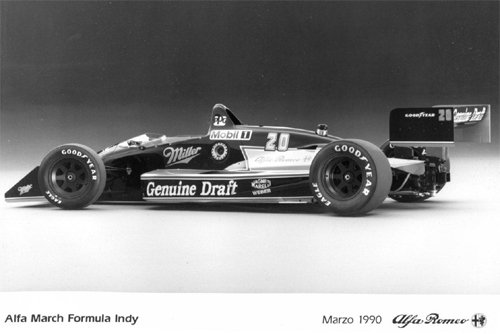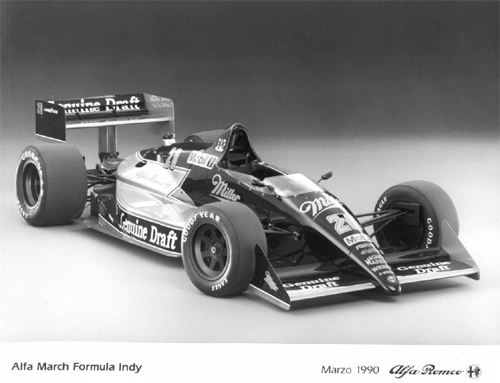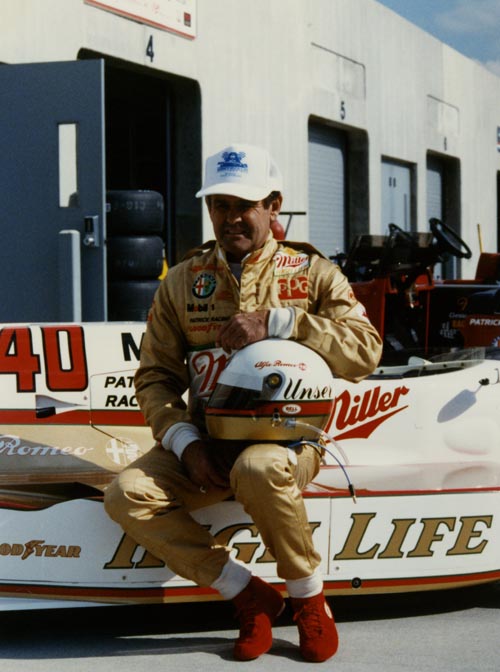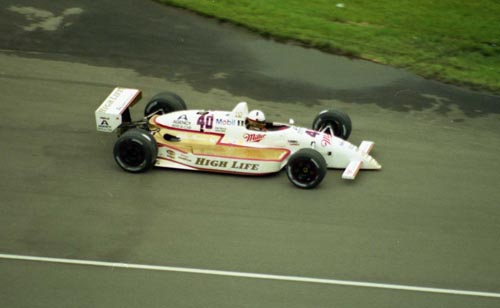Fiasco Italo-Brittanico
Part 12: 90CA on active duty - up to halfway into the month of May
Author
- Henri Greuter
Date
- May 12, 2009; updated on December 9, 2011
Related articles
- March-Alfa Romeo 90CA - Fiasco Italo-Brittanico, by Henri Greuter
- Introduction
- Part 1: Alfa's inverse Midas touch
- Part 2: Indy teams keep on March-ing
- Part 3: The Indy project that became a blackmail project
- Part 4: Patrick Racing, a brief history up to 1989
- Part 5: 1989 - Alfa picking up the pieces
- Part 6: 1989 - Winning major prizes on the road to losing everything
- Part 7: 1989 - The first Alfa Romeo-powered CART racer
- Part 8: 1989 - A hopeful start for Alfa Romeo
- Part 9: Preparing for 1990
- Part 10: The 90CA in more detail
- Part 11: Exhaust solutions a 'waste' of effort?
- Part 13: 90CA on active duty - the early part of the second week of practice at Indianapolis
- Part 14: 90CA on active duty - wrestling through the second week of practice and qualifying
- Part 15: 90CA on active duty - about the Alfa Romeo V8 engine
- Part 16: 90CA on active duty - the last part of 'Indianapolis'
- Part 17: 90CA on active duty - after Indianapolis
- Part 18: The end of the road for March in CART and as a whole
- Part 19: The left-over hardware and where to find it
- Part 20: Final verdict on the March-Alfa Romeo 90CA
- Appendix I: Specifications
- Appendix II: Results and scores
- Appendix III: March-Alfa Romeo 90CA-related collectables and memorabilia
- March-Porsche 90P - The last oddball at the Indianapolis Motor Speedway, by Henri Greuter
Who?Al Unser Sr What?March-Alfa Romeo 90CA Where?Indianapolis When?1990 Indianapolis 500 |
 |
Why?
To get a better understanding of the task awaiting the Patrick Racing team members, remember that the team almost had begun from scratch again. The majority of the team members had decided to stay with Patrick but apart from then their boss they had lost everything. The entire infrastructure of the team had gone over to Chip Ganassi. Once Pat Patrick had decided to continue racing after all, all team members were given the choice to go to either Chip or Pat. The majority of the crew elected to stay with Pat.
Team member Scott Roembke described it as follows: “It was not an easy decision for anybody as Chip was very committed to a plan which time has proven to be very successful. Chip did keep Tom Anderson to become his team manager and Chris Griffis to be his chief mech amongst a few others. Pat had secured the Miller sponsorship and the Alfa deal which made continuing with a new team worthwhile for him.”
Roembke added: “The new Patrick Racing did lease John Capels' shop but we purchased new or constructed most of the equipment needed. We ended up running the raceteam out of the Hemelgarn shop and used the Capels shop for the Alfa mechs and engine prep and storage. We started 1990 with a new cell phone and a folding table and started to order up what was needed. It was pretty heady times building a “top tier” raceteam from scratch.”
According to Johnny Capels, he also sold some equipment to Patrick Racing since the team had nothing whatsoever. He was approached by Patrick Racing after he made the decision to withdraw his team from active racing and his properties were now redundant to him, yet useful for the new Patrick outfit and Capels was more than willing to help out a friend.
Around the end of November, once all financial matters were dealt with, Capels had handed over the three cars he had used that year to Alfa Romeo for whatever use they still could have. But given the uncompetitiveness of the 89CEs during 1989, it was clear that the cars were of little if any value for active track duty.
That was the cradle in which the 90CA had to be raised and nursed into a competitive machine.
As for the 89CEs being used, as we shall see, one task for which older retired cars were frequently used was indeed taken up by at least one of them: PR and showcar duties.
Early 1990 (March or thereabouts) Alfacorse released photos of a car painted in a Miller Genuine Draft livery. More than likely the first of the 90CAs was not available yet so that is why an older car subbed. The livery in the pictures was later used on the primary entries raced by Patrick Racing Alfacorse during 1990, driven by Roberto Guerrero.
Based on the fact that this show car has pullrod suspension, this must be a March 88C, most likely it is the ever faithful muletta 88C-009.



PR photos released by Alfacorse featuring one of the older cars wearing the livery Patrick Racing Alfacorse
would eventually use on their 1990 cars driven by Roberto Guerrero.
(all pictures copyright Alfacorse PR, provided by Martin van der Hulst)
90CA brought into action
The first of the 90CAs was delivered a bit late, it was March already. The car was tested in the USA at the Memphis Raceway road course about mid-March, being looked after by the Patrick team. No records were broken but there were no problems of any kind and the team knew what needed to be done. Mo Nunn declared that the car handled well and no changes were required for the yet to be built follow-up chassis.
Then in early April the team tested the car at the Phoenix International Speedway, a week prior to the season opener, also held at Phoenix. Lots of work had been done on the engine and Guerrero reported a “quantum leap” of progress. The tests were carried out simultaneously with the Porsche team and Alfa was half a second faster. Alfa Romeo also announced that apart from all other updates on the current engine, a new short-stroke version was being developed which would be more compact and have a lower CoG. It was anticipated that this engine would be introduced sometime during the season. And to better co-ordinate the entire effort a technical committee was founded in which representatives of Patrick Racing, March Engineering and Alfa Romeo met with one another.
According a team member, one of the things about the car that the team did find out early on in testing was that the opening on both the inlet and the outlet of the turbo was way too small and needed to be opened up.
But how committed was Alfa Romeo really? At the same time they also announced plans to build a V12 sports car engine that was to be tested against the existing V10 (ProCar) engine for the yet to be finalized sportscar project for 1991. No distraction from the CART program in any manner?
Only a single 90CA driven by Roberto Guerrero appeared at the first two CART races of the season. Guerrero was optimistic about what was to come during the season opener at Phoenix. He proclaimed the car felt very good though still a bit down on power. But since Alfa was still working hard on the engine he expected many improvements during the season. Qualifying 14th was not that bad at all. In the race itself Roberto spun out; he claimed the car had run well up to that point but all of a sudden the car had got a little loose and he lost control. 16th place was all that was left to cheer about.
Long Beach was a different matter. In practice the car appeared sluggish and the engine was definitely not on par with the opposition. Guerrero admitted that it was not so bad above 7000rpm but acceleration from 4000rpm on was bad. In practice, he was 19th fastest of 25 starters. Even worse, news leaked out that the March-Alfa was overweight too! A 14th place at the finish, 5 laps down on the winner was the final result, which was not something to get excited about. Prospects for Indianapolis weren’t looking very bright unless the more powerful “Phase III” engine would be employed and reliable as well.
Four cars were entered for Indianapolis. The official entry list in the 1990 program lists four entries numbered 20, 20T, 40 and 40T. All cars were identified as 1990 March-Alfa Romeos. Roberto Guerrero was entered to drive car no.20, Al Unser Sr for car no.40.

Al Unser Sr posing with his 1990 ride. (photo courtesy John Darlington)
As for Pat Patrick Racing numerology: numbers ending on 0 had not been used at Indianapolis before 1967. The Granatelli team used 40 on their legendary turbine car of 1967 and a number of STP-sponsored cars used numbers ending on 0 from then on. When the Granatelli team quit their own participation, the STP money went to Pat Patrick Racing and he took over the habit of using the RocketRed color of STP as well as using numbers ending on 0. The ones he used the most were 20 (Gordon Johncock’s regular number) and 40. In case of a third car raced, that was no.60 most of the time.
As far as I know, only three 90CAs ever made it to the Speedway that month. Of two cars I am certain about their numbers: the 20 and 40. The cars looked very different from each other, no.20 was in Miller Genuine Draft colours, primarily black and gold. The no.40 promoted Miller High Life and was painted white and gold. A third car appeared later on, painted white like the no.40. The number I saw on that car was 20T, but it ran with USAC identification number 82 at the roll hoop. Later on it transpired that the third 90CA had been delivered shortly before May. This suggests that a fourth chassis was not ready in time to be sent to Indianapolis. If a fourth car made it to Indianapolis, it might have been one of the 89CEs. One of these was exhibited at the Motorsport area of the Sitev Technology show in Geneva held in mid May. After the show it was to be sent to Indianapolis in order to be a spare car for the upcoming 500-mile race. If this 89CE car made it to Indianapolis, it probably stayed behind in the Patrick workshops; I never saw the car in Gasoline Alley. In the week before the race I was in the Patrick shop for a brief period. I could not take pictures but I didn’t see a car that could have been a 89CE. The 90CA parked in the shop was the one I had seen already.
A major disappointment for the team occurred when the eagerly awaited “Phase III” engines were not ready so the elderly, underpowered “Phase II” had to be pressed into service yet again. Guerrero was the first to appear at the Speedway with an Alfa Romeo-powered car in 1990 on Monday May 7th.
During the first week of practice for the 500 miles, the Alfas didn’t set the world on fire. But the crowds at the track certainly knew it when one of the cars was driven at speed. For some reason, the noise from the Alfa engine was clearly different from any other quadcam V8 engine. The Alfa screamed and had a high-pitch howl like no other car at the track.
“Didn’t set the world on fire” Indeed, I wrote that a few lines ago. But its bodywork was! Tuesday May 8 was a day when the bodywork of both cars went partly ablaze, hampering progress. In Unser's case it happened during his first laps of the year. Engineer Mo Nunn blamed a porosity in the plenum chamber of the turbo manifold through which methanol had been leaking onto the engine before the fire.
During that first week of practice neither Guerrero or Unser made it into the top-ten fastest drivers at the track on any given day.
Causing major controversy at the track that year were the diffusers, the inserts within the sidepods of the pre-1990 design cars to lower their underwing profiles to the 1990 rules. These inserts reduced the downforce levels generated by the sidepods so much that it slowed the cars down tremendously. So much in fact that the chance to still be competitive despite using a one-year old car appeared to be gone. A number of teams were regretting their decision to stick with older cars instead of buying a new Lola. A number of crashes happened that first week of practice, every one of them with cars at least one year old and modified to meet the new regulations. Only the TrueSports team had taken the efforts to hire wind tunnel time and develop their own, new undertray for their 1989-type Lola-Judd T89/00. Of all the teams with older cars they were among the fastest and with the least handling problems.
Al Unser put down the fastest lap with a March-Alfa on Friday May 11, averaging 214.592 mph, Guerrero also set his fastest lap of the month that day with 212.384 mph. Al Unser Jr in a Lola-Chevrolet put down the fastest lap of the month that same day with a monster speed of 228.502 mph. But the highlight of the day was, no doubt Jim Crawford's crash whose Lola-Buick (a one-year old car with diffusers inserts…) swapped ends and then took off. He got as high as six feet above the ground but mercifully landed in upright position and got away from the experience without any serious injury.
Saturday May 12 was Pole Day but it was rained out completely. The next day the track dried off enough to allow some practice and qualifying in the afternoon.

Roberto Guerrero practising on Sunday afternoon May 13 before qualifying could start. (photo HG)

Though likely unable to get a chance to qualify that day, Al Unser Sr also went out to practice his car. (photo HG)
None of the Alfas made it into the field that day. Only Roberto Guerrero had drawn a number for the qualifying line of cars that had a guaranteed shot for Pole. Al Unser was nominated a second-day qualifier to begin with, and was never eligible for pole. But when qualifying ended at 6 o’clock that Sunday afternoon, Roberto’s turn and that of 14 other hopefuls had yet to come. Roberto was in good company, among the drivers still eligible for the pole were the surprisingly quick and consistently fast Arie Luyendijk and the fastest man up until then, Al Unser Jr. They also had to wait until next weekend.
Though not qualified yet, there was talk about this fact being a blessing in disguise for Alfa Romeo. In ABC's coverage of Pole Day there was talk about newer and stronger engines being ready in time later on in the week. If true, and these engines being reliable too, that could only improve the performances of the Alfas in qualifying and make them less vulnerable to being bumped.
That first weekend of qualifying ended with former Patrick Racing driver Fittipaldi on pole position for the time being.
